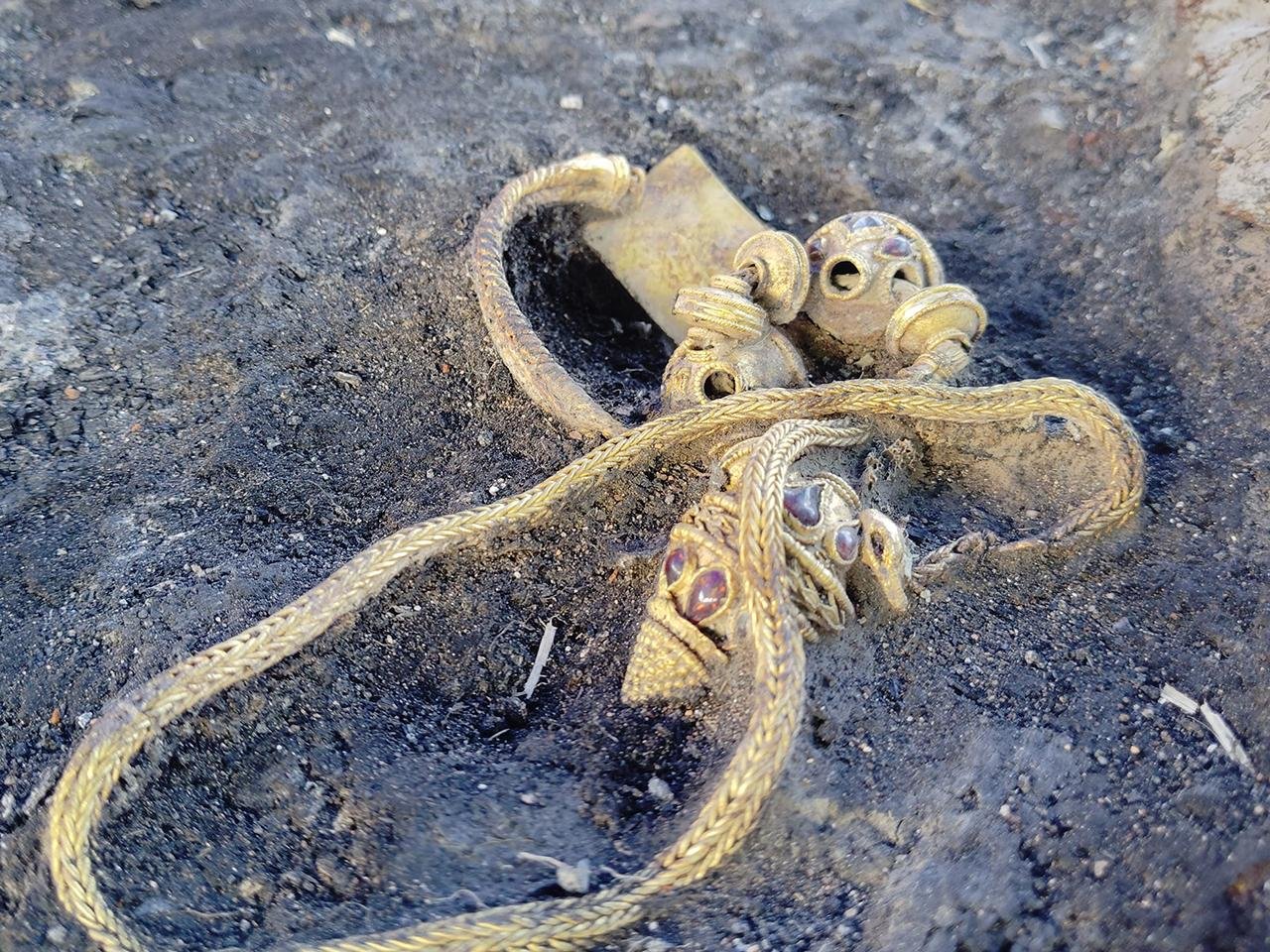Archaeologists in Bulgaria, led by Daniela Agre from the National Archaeological Insтιтute with Museum at the Bulgarian Academy of Sciences, have unearthed a Thracian warrior‘s tomb filled with unique artifacts dating back to the early 1st century CE in the village of Kapitan Petko Voyvoda.
 Unique gold artifacts found at the site. Credit: Topolovgrad Municipality
Unique gold artifacts found at the site. Credit: Topolovgrad Municipality
The tomb, believed to belong to a Thracian aristocrat who served in the Roman military, contained an impressive array of grave goods. Among the most notable finds were several gold items, including a necklace, a diadem, a ring, and a knife adorned with gold elements and semi-precious stones. The knife is particularly unique, with a handle encrusted with precious stones and a gold band intricately depicting hunting dogs, a design that archaeologists have not seen in Thrace before.
In addition to the jewelry, the tomb also held numerous weapons such as swords, spears, a decorative knife, and a rare plaited breastplate, which was uncommon during the Roman period. The warrior’s full battle gear was laid to rest with him, signifying his status as a well-equipped soldier. Adjacent to the burial site, the skeletal remains of a horse were discovered, further indicating that the warrior was a mounted horseman, a prominent feature in Thracian culture.
The Thracians were an Indo-European people who inhabited areas that now include Bulgaria, Romania, northern Greece, and parts of Turkey. Emerging during the early Bronze Age, they developed a distinct warrior culture that left a lasting impact on the military history of the Balkans and surrounding regions. Known for their skill in light infantry, particularly as peltasts, Thracian soldiers were recognized for their distinctive crescent-shaped pelta shields made of wicker covered in goat or sheepskin. These warriors played crucial roles in the armies of neighboring civilizations such as the Greeks, Persians, and Romans.
Thracian peltasts were renowned for their agility and versatility in battle, often armed with a variety of weapons including knives, swords, and spears. From the 4th century BCE onwards, they became integral to Greek military formations and participated in significant campaigns, such as Alexander the Great’s conquests into Asia.
The discovery of the horse alongside the warrior ties into the broader cultural significance of the Thracian Horseman, a revered figure in Thracian mythology and iconography. Often depicted in ancient reliefs and monuments as a mounted warrior or hunter accompanied by a dog, the Thracian Horseman is ᴀssociated with both martial prowess and religious symbolism. These depictions suggest a deep connection to funerary practices and beliefs about the afterlife.
The Thracian Horseman may have been worshipped as a hero-god, embodying both divine and mortal qualities. His ᴀssociation with the Thracian sky and horse god Sabazios, later connected to Zeus by the Greeks, reflects a syncretic blending of Thracian, Greek, and Roman religious practices. Even after the Roman conquest of Thrace, the image of the Thracian Horseman persisted, highlighting the cultural and religious continuity of Thracian traditions.
The artifacts recovered from the tomb are currently being conserved under police protection and will be transferred to a specially prepared room in the History Museum in Topolovgrad.
Daniela Agre, who led the excavation, described the findings as “unparalleled among those ever discovered in Bulgaria.” She emphasized the significance of the ornate hunting knife, stating, “This knife with its precious stone handle and unique motifs is unlike anything we have found in Thrace from this period.”
This finding offers fresh insights into the vibrant cultural landscape of ancient Thrace and highlights the region’s importance within the larger context of European history.





